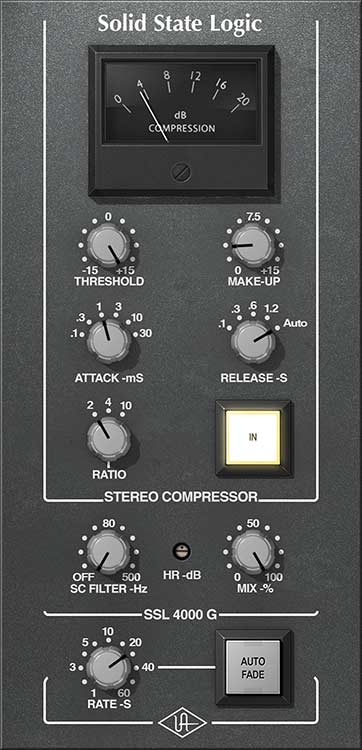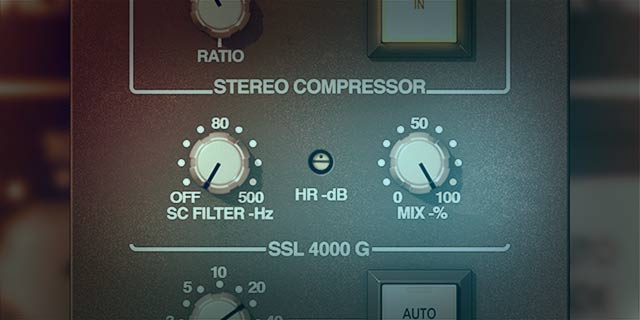New Gear Review: UA SSL 4000 G Bus Compressor Collection

While going to painstaking lengths to precisely emulate the classic SSL 4000 G Bus Compressor, Universal Audio adds tasteful new features to support modern workflow.
New to Universal Audio‘s growing lineup of compressor emulations is the venerable SSL 4000 G Bus Compressor Collection.
One of the most famous bus compressors of all time, the 4000 G has arguably been put across the stereo bus of more records than any other.
It’s also possible that this model has been subject to more clones—both hardware and software—than any other compressor, once you count all the rack-mountable, 500-series and plugin versions from competitors and from SSL themselves.
The main operating component of the G Bus Compressor is a VCA, or “Voltage-Controlled Amplifier”. Effectively, an input signal voltage triggers an amplifier to change the output gain value.
There are many types of compressors out there, including Tube, FET, and Optical. BUT VCA compressors tend to be capable of acting fast and “grabby”, while also allowing versatility.
Keen users may note that there already was an SSL Bus Compressor model released by UA… However, this is an entirely new beast and not just an update to the original.
Harris Barnard of UA’s media relations, outlined for me just what makes this model different. He noted that this is the only “end-to-end” emulation of the famous compressor, including the unique control voltage summing, and that it has SSL’s blessing and their own independent verification of its sonic properties.
““[The engineering team] underwent a 6-month research period, poring over proprietary ‘for-your eyes-only’ schematics made available by SSL’s engineering staff,” he said. “SSL engineers were always available for assistance with any inquiries from our team regarding the design. Simultaneously, UA’s plugin development team analyzed and measured our specimen units to ensure one of the tightest sonic and behavioral circuit models to date, well within our goal of analog unit to unit variation.”
In addition to this efforts of faithfully recreating the original in tandem with SSL, several new features were added to modernize the workflow. Let’s dig in and take a closer look at what it has to offer.
Features
The look and feel of the GUI here is fantastic, very closely resembling the original model, which itself is a marvel of simplicity and ease-of-use. “Skeuomorphic” designs can sometimes cause more problems than they are worth, but here it translates very well indeed.
Across the top is the iconic gain reduction meter. The basic controls below exist as they have for over 30 years now: threshold and make-up gain, attack times (.1, .3 ,1, 3, 10, and 30 ms), release times (.1, .3, .6, 1.2 seconds and an auto-release feature), ratio (only 2:1, 4:1, and 10:1), and lastly, the lighted “IN” button allowing you to bypass compression. (Thankfully, this last feature does not accurately model how often those little light bulbs burned out on the original.)
The new-to-this-model features include a continuous sidechain high pass filter up to 500 Hz, a wet/dry mix control, and a variable headroom setting. Lastly, a feature available on the SSL hardware but not on many of the clones, is an auto-fade feature. The SSL Bus Compressor is unique in that it originated as part of the console, and not a stand-alone device. The compressor circuit was actually part of the VCA master fader itself. The SSL computer allowed for an auto-fade which tapered out the signal over a period of 1-60 seconds. The Universal Audio model captures the exact taper of that fade.
Additionally, it should be noted that this is a stereo compressor and does not offer dual-mono operation. Meaning, both left and right channels will always receive the same amount of gain reduction. This works great for ensuring that your stereo image remains rock solid and doesn’t shift in any way, which is especially useful as gain reduction gets larger.
In Use
Those of you familiar with this compressor will be excited to try it, as the redesign offers a whole new level of accuracy and sound quality. I’ve worked on both the consoles and the first UA SSL G Bus Compressor (still available for purchase, now known as Legacy), and I’m happy to report that it sounds exactly like it should.
The general application of this compressor has always been across the stereo bus. I find it to just give my mix the right amount of hug to bring it all together. The fast attack settings make it great for taming the drum transients that otherwise pop out. The auto-release feature is program dependent and multi-stage, allowing for greater transparency. I love the way the grabby nature of this compressor can congeal the separate elements of a mix together. And the beauty of a software version is that it can be instantiated on individual instruments or submixes as well.

A closer look at some of UA’s added features to this classic tool: the variable sidechain filter, headroom control, and mix knob.
The new features of this design make tuning it to modern mixes a much easier process. The new sidechain filter allows you to have a huge low end that might otherwise pump and breathe heavily, without driving the circuit wild. It’s great for fast bass and synth lines that need to be controlled without making the bottom octaves turn to mud.
Additionally, the mix control allows for you to absolutely pummel the source, and then blend it back in with the original—great for adding weight and body without losing transients. Parallel compression is much more commonplace and popular now, so it’s nice to see updated features to match modern workflows.
My favorite new feature however, is undoubtedly the headroom control. This feature would be impossible to implement in actual hardware. With physical components, there is a set noise floor, and a set overload point. You don’t have a say in the matter, and must be careful when setting your gain stages to hit the gear at its optimal operating level.
Digital workflows and headroom vary greatly in dynamic range, and floating bit systems allow for internal operating that effectively cannot be over-modulated. However, this compressor is modeled after an analog set of components, and inherently has the same overload characteristics. This is a big part of the sound of any hardware, or hardware emulation. Driving the input of this unit just to distortion (or even well beyond) is a key component many mix engineers have relied on. The headroom control allows for you to hit this device at the proper level regardless of the gain staging in place before it.
To Be Critical
To state that music and the tools we use to create it have changed since the 1980s is an understatement of epic proportions. The loudness, frequency response, and dynamic range of modern music often requires more flexibility than is offered by many tools.
I always think of the ratio control as a means of giving the mix a harder or softer feel, and limited choices here means there are no in-between settings. Fixed attack & release time constants don’t allow you to work as surgically as many wish, and emphasizing the rhythmic characteristics of music, or making it pump in time, is an often desirable result of compression for many.
The very same features that make this particular compressor easy to use give it constraints as well. But this is an emulation of a classic tool, and any departure from the original design must be judiciously implemented so as to not work against that vision.
Additionally, I would love to see an unlink option, allowing for dual-mono operation. I often find that to be more rhythmically interesting, and don’t feel the addition of this feature would harm the intent of this emulation.
Summing it Up
There are tons of compressors out there that offer an endless array of features and controls. The UA SSL 4000 G Bus Compressor isn’t designed to be a new do-it-all compressor. Universal Audio has a goal here of accurately emulating a very unique piece of gear, and for those looking for THAT (pun intended) sound specifically, I’m happy to report it is a rousing success. The Universal Audio SSL G Bus Compressor Collection is available today for $299.
Please note: When you buy products through links on this page, we may earn an affiliate commission.






